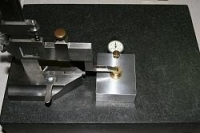Making one fixture creates the need for another tool for the shop.
In the past I would just use a feeler gage to set my tool bit height on the CNC or Mill.
Well for engraving with the tiny carbide cutters I needed a safer way to plunge the tool to the surface of the work.
Many are available and are priced from $330.00 to $14.00 (14 bucks was a rough plastic with cheap dial indicator (import of course).
I had a nice GEM dial test indicator and that seemed like a good fit for this project.
No indicators were harmed in the creation of this tool!
The indicator may be removed and used as originally intended.
This is a real easy build. I started by cleaning up the block of aluminum for the base.
The base is 1" thick and was to be 2" by 2" square. However I really hate to throw away aluminum or any other material.
Since my blank was 2.75" by 2.2" I just cleaned it up and squared it up on the mill.
It ended up 2.146" by 2.631" and .975 thick.
A piece of 5/8" brass was drilled and threaded 1/2-20". A brass plug was threaded 1/2-20. This is the zero adjustment.
The base has a 5/8 hole reamed which is used to house the zeroing/measuring plunger.
The plunger has a 5/8" (just under) spring to hold the plunger up.
The indicator is mounted with a .332 (letter Q) drill bit. That hole intersects the 5/8" hole for the plunger.
Only tricky part was getting the indicator in the hole!. While the diameter of the shank of the indicator is .328 there is
a wider part at the lever end where the rivet protrudes. So I had to mill a slot from the bottom side so the indicator could be installed.
Trickey part #2 is orienting the lever between the spring coils so the coils do not get deflected by the spring. No problem,
just compress the spring one coil space and it is 100% out of the way.
Set it up using the height gage and put a small amount of blue loctite to keep the plunger set.
Works like a champ at a cost of a small piece of brass, small chunk of aluminum,one spring, and one thumb screw.
Cheers, JR


 LinkBack URL
LinkBack URL About LinkBacks
About LinkBacks


 Reply With Quote
Reply With Quote



Bookmarks